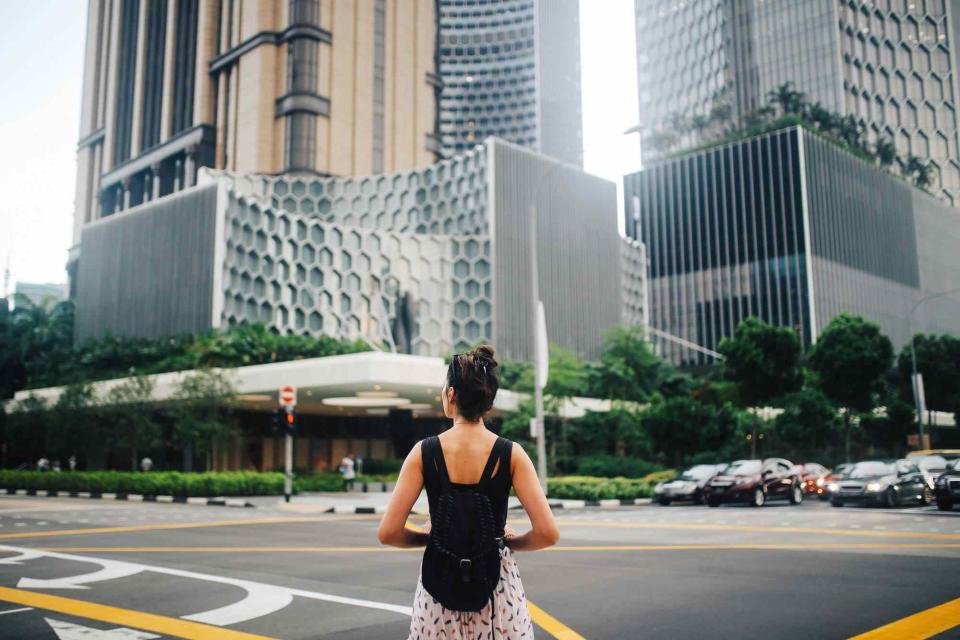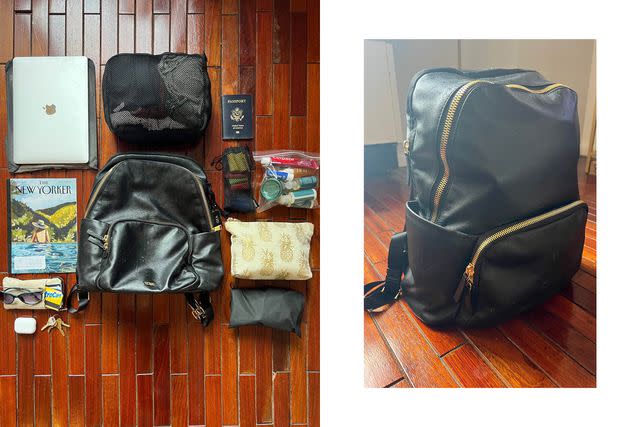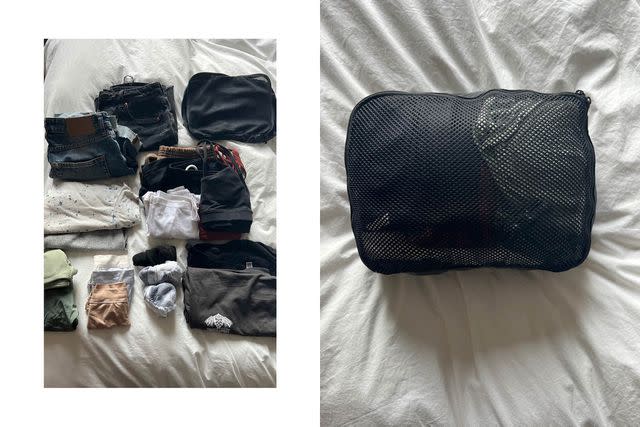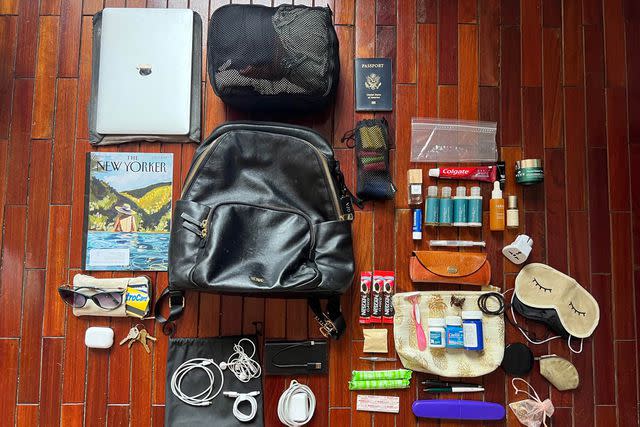I Take 3-day Trips With Only a Backpack — Here's Exactly How I Pack
How a professional travel writer packs for three-day trips with only a backpack.

Getty Images
Long-weekend getaways are the gift that keeps on giving, but airlines that charge exuberant carry-on fees are anything but. In the Basic Economy era, navigating the world of getting away with just a personal item is becoming increasingly more useful.
I’ve been traveling with just a carry-on for many years and have mastered the art of making the most out of the space offered by a simple backpack. Follow the eight steps below, and you’ll be on your way to doing the same in no time. This is a blueprint of how I personally make sure all of my bases are covered when getting out of town for a long weekend, though swaps and personal tweaks are absolutely encouraged.
Step 1: The Backpack

Vicki Denig/Travel + Leisure
For those who travel frequently, investing in a good backpack is key. Last year, I treated myself to this Tumi Voyageur black leather backpack around the holidays, though rest assured, any average-sized backpack will do here. I personally recommend looking for one that has some form of front and/or side pockets (my Tumi has both), as well as a separate zipper slot for your laptop or tablet. The inside here is pretty standard, and while there is an interior back section that can close off by zipper, I only really use that part of the bag to store my passport, so I can keep it handy.
Step 2: The Clothes
Clothing is by far the biggest hurdle when packing for three days and definitely promises to take up the most space in your backpack. Enter: the packing cube, the higher power’s saving grace to compact travel. A key trick here is to wear what you’ll wear on the first day on the plane, as well as layer up with any additional items. This leaves you with just two days to pack for. That means three pairs of undergarments and three pairs of socks. I then add a bathing suit (optional), pajamas, two t-shirts, two pairs of shorts or pants, and even two workout outfits (again, optional).
Many of these items can be repurposed, too. For example, t-shirts from the day prior can be worn for a workout the next day (they’re dirty anyway), and designated gym shorts can be used as a quick bathing suit cover-up before wearing them to work out.

Vicki Denig/Travel + Leisure
Step 3: The Liquid Toiletries
Perhaps a hot take, but I tend to keep the liquid toiletries bag as simple as possible, mostly because the majority of hotels will have these items on hand anyway, and you can often quickly purchase your preferred brand of travel-size items when you land. I also stick with a clear ziplock bag over a cute toiletry bag, which expedites things at security.
I pack travel-sized shampoo, conditioner, lotion, and bodywash, as well as a vitamin-C oil (feel free to add another small skin care product or two to this bag), toothpaste, lip balm, and a teeth whitening pen. I also have two mini-sized perfumes in here.
Step 4: The Miscellaneous Bag
I like to think of my backpack’s miscellaneous bag as equivalent to my kitchen’s junk drawer; it’s loaded with a bunch of random things, though it always seems to pull through when the need for something obscure arises. Of course, seeing as we’re dealing with minimal space here, the contents of the ‘junk drawer’ bag will naturally be more dialed back, as every bit of space within the 72-hour travel backpack counts.
For me, miscellaneous-yet-essential items look like the following: three instant coffee packets, earplugs, a set of tweezers, a few tampons, a handful of Band-Aids, two pens, a toothbrush, a little bag for jewelry, a small change purse for local currency, a compact mirror, two eye masks (yes, I’m insane), hair ties, prescription medication, allergy meds, sleeping meds, a razor, hair clips, a few hair ties, glasses, and a converter. Again, these are totally subjective, but should you follow this section exactly as written, you’ll notice there’s still a bit of extra room for you to throw some additional smaller items in there.

Vicki Denig/Travel + Leisure
Step 5: The Wires
For those looking to stay connected while on the road, ensuring that you’ve got all of the right wires in place is key. For me, this looks like my computer charger, a lightning iPhone cable, a USB cable (specifically for airplane charging, as most are not yet equipped for newer iPhone chargers), and the USB charger for my portable battery — as well as the portable battery, of course. You can throw a phone charger wall brick in here, too, though I tend to just plug my lightning cable into my laptop, then connect the laptop to the wall. I also always bring a spare pair of old-school headphones, just in the unfortunate case that my airpods are dead.
Step 6: The Random Essentials
Random essentials are things that don’t necessarily fit in your miscellaneous bag, though are necessary items nonetheless. For me, this looks like my laptop, something to read (magazines are clutch here), my keys, airpods, and sunglasses. My sunglasses holder also has a bit of room for a few additional cards I don't keep in my wallet.
Step 7: The Assembly
The assembly is a bit like tetris, but rest assured, it’ doesn't take too long. Start with your packing cube of clothes and place that in first. Next, be sure to put your passport somewhere in a designated section of your backpack; for me, it’s that back zipper area. Next, add the toiletry bag, wire bag, and miscellaneous bag on top of the clothing cube. Place your laptop/tablet and reading material in the back zipper pocket. Add your keys, airpods, wallet, and water bottle to the side pockets, or simply use the pockets of whatever you’re wearing.
Step 8: Additional Items
The outfit you wear when you leave the house on your first day will be your outfit for day one — as well as your key to getting away with a few additional items. Generally, my go-to travel day/first day outfit is a pair of jeans, a plain white t-shirt, and a jacket (depending on the season). I also always bring a sweatshirt and either a) wear it if it’s cold or b) tie it around my waist. Should you care to bring a hat, scarf, or any other clothing accessory, be sure to wear those, too. With regards to additional items added to the backpack itself, I’ve found that tying a pair of sandals in a small bag (I usually board wearing sneakers) and attaching it to the backpack never seems to get me in trouble.
For more Travel & Leisure news, make sure to sign up for our newsletter!
Read the original article on Travel & Leisure.

